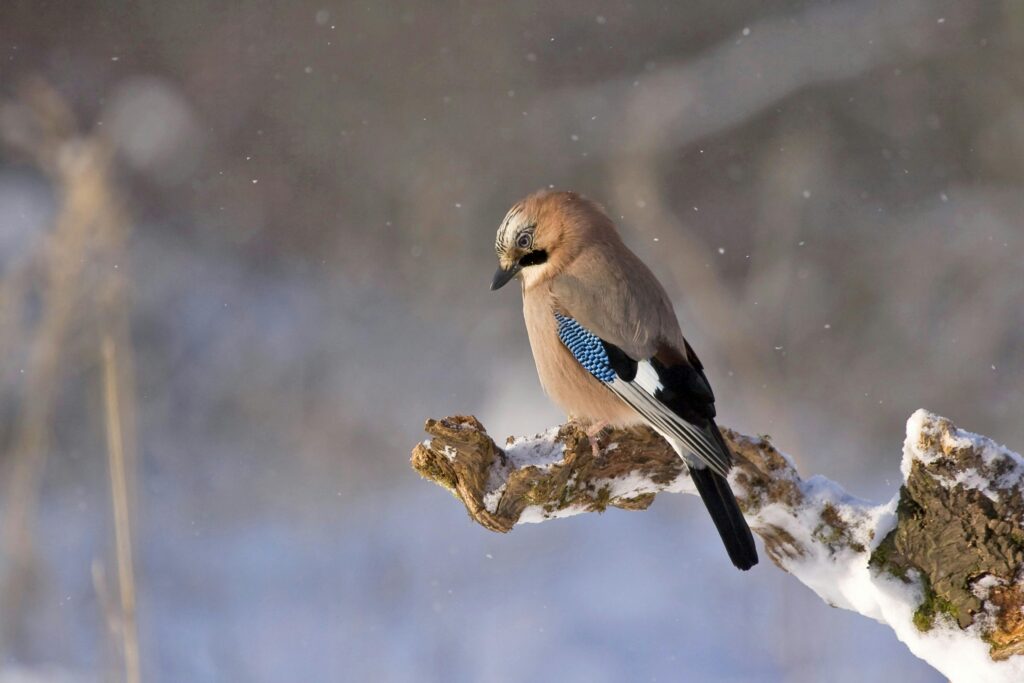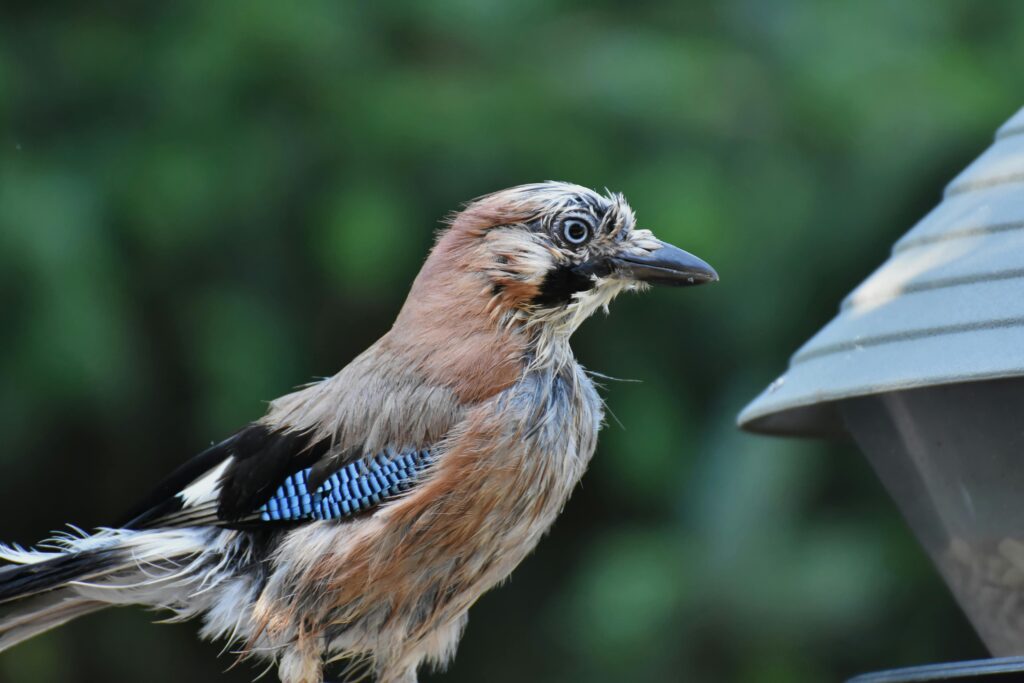Eurasian jays are among the most visually stunning birds in the Corvidae family, known for their vibrant plumage that features shades of blue, pink, white, and black. These striking colors have fascinated birdwatchers and scientists alike, prompting questions about the purpose and origin of their unique appearance. The vivid coloration of Eurasian jays is not merely for aesthetic appeal—it serves crucial roles in survival, reproduction, and communication. From intricate feather structures to environmental influences, a variety of factors contribute to their remarkable hues. This article delves into the reasons behind the Eurasian jay’s colourful plumage, exploring the biological, environmental, and evolutionary factors at play.

The Unique Plumage of Eurasian Jays
Eurasian jays are renowned for their distinct and colorful feathers, which set them apart from other members of the crow family. Their plumage features a harmonious blend of soft pinkish-brown tones, striking black streaks, and an unmistakable patch of vibrant blue feathers on their wings. These blue feathers, marked by intricate black and white barring, are particularly eye-catching and have become a defining feature of the species.
The unique combination of colours provides more than just aesthetic beauty—it plays a functional role in their survival. The pinkish-brown tones help Eurasian jays blend seamlessly into the forest environments they inhabit, offering camouflage from predators. At the same time, the vivid blue feathers serve as a means of visual communication during social interactions and territorial displays. This dual-purpose plumage reflects the complex relationship between coloration and survival in the natural world.
How Coloration Aids in Camouflage
Camouflage is a key survival strategy for Eurasian jays, allowing them to remain inconspicuous to both predators and prey. The earthy tones of their body feathers mimic the colors of tree bark, dried leaves, and soil found in their woodland habitats. This natural blending helps them evade detection while foraging or resting in the dense undergrowth.
In addition to blending in, their ability to stay still and avoid unnecessary movement further enhances their camouflage. The blue wing feathers, while highly visible during flight, are often hidden when the bird is perched, ensuring that they don’t attract unwanted attention. This strategic use of coloration demonstrates how Eurasian jays leverage their plumage for both concealment and communication.

Role of Pigments in Eurasian Jay Feathers
The vibrant coloration of Eurasian jay feathers is largely a result of specific pigments and structural adaptations. Two primary pigments are responsible for their striking hues: melanin and carotenoids. Melanin creates the brown, black, and gray tones in their plumage, while carotenoids contribute to their softer pinkish-brown shades. Interestingly, the vivid blue patches on their wings are not caused by pigments but by structural coloration—a phenomenon that manipulates light to create brilliant colors.
Structural coloration arises from microscopic structures in the feathers that scatter light in a way that amplifies specific wavelengths, such as blue. Unlike pigments, which rely on chemical composition, these structures interact with light to produce iridescent and vibrant hues. The result is a dazzling blue that can vary in intensity depending on the angle of light, making the feathers appear dynamic and alive.
How Light Refraction Creates Vibrant Hues
The science behind the blue feathers of Eurasian jays lies in a phenomenon known as light refraction. The microscopic arrangement of keratin and air pockets in the feather barbs creates a layered structure that refracts light. This selective scattering amplifies shorter wavelengths in the blue spectrum while absorbing longer wavelengths, such as red or yellow. As a result, the feathers appear blue to the human eye.
This effect, called structural coloration, is particularly advantageous for birds like the Eurasian jay. Unlike pigments, structural colours do not fade over time, ensuring the bird retains its vibrant appearance throughout its lifespan. The shimmering quality of the blue feathers also makes them highly noticeable, playing a role in social signalling and mate attraction.
Adaptive Advantages of Colorful Feathers
The vibrant feathers of Eurasian jays serve critical functions that go beyond aesthetics. These colourful features play a vital role in communication, mate selection, and establishing social hierarchies within their populations. Birds often use visual signals to convey important messages, and the Eurasian jay’s plumage is a prime example of how coloration can serve as a form of non-verbal communication.
During the breeding season, the brighter and more defined colours of a jay’s plumage can indicate health and vitality to potential mates. This makes colourful feathers a reliable signal of fitness, helping individuals select the best partners to ensure the survival of their genes. Similarly, colourful plumage may also deter rivals or predators by showcasing the bird’s strength and confidence, reducing the likelihood of physical confrontation.
Communication and Mating Displays
Eurasian jays use their colorful feathers as a means of visual communication, especially during mating rituals. Males often display their blue wing feathers prominently when courting females. This behavior not only highlights their striking plumage but also demonstrates agility and fitness. A vibrant and well-maintained plumage can signal to a potential mate that the bird is healthy, free from parasites, and capable of providing strong genetic material for offspring.
In addition to courtship, their coloration also helps maintain social order within groups. Dominant individuals often exhibit brighter plumage due to better access to resources and less stress, which further reinforces their status. By using their feathers as communication tools, Eurasian jays avoid unnecessary conflicts and strengthen social bonds within their communities.
Environmental Influence on Eurasian Jay Colors
The environment plays a significant role in shaping the coloration of Eurasian jays. From diet to habitat conditions, external factors can influence the vibrancy and quality of their plumage. A healthy diet rich in nutrients, particularly carotenoids, enhances the pinkish-brown tones in their feathers, while access to diverse habitats allows jays to maintain the health and brilliance of their coloration. Seasonal changes and moulting cycles further impact their appearance, ensuring that their feathers are always in prime condition to serve their functional purposes.
Environmental stressors, such as habitat degradation or food scarcity, can lead to duller plumage, signalling poor health or reduced fitness. This makes their feathers not only a tool for survival but also an indicator of environmental quality. Observing changes in jay plumage can even offer insights into the health of their ecosystems.
Seasonal Changes and Feather Brightness
The colors of Eurasian jays’ feathers can vary subtly across seasons due to molting and environmental influences. Molting, a natural process where birds shed and regrow their feathers, ensures that damaged or faded feathers are replaced with new, vibrant ones. This allows the jays to maintain their bright and functional plumage year-round.
In addition to moulting, seasonal variations in light and habitat conditions can affect how their colours appear. During autumn and winter, when natural light levels are lower, the earthy tones of their feathers provide better camouflage against bare trees and fallen leaves. Conversely, in spring and summer, their brighter colors become more pronounced, aligning with breeding season when visual signaling is most critical. These seasonal shifts demonstrate how Eurasian jays adapt their appearance to their changing environments.
Genetic Factors Behind Feather Coloration
The striking plumage of Eurasian jays is deeply influenced by their genetic makeup. Specific genes regulate the production and distribution of pigments like melanin and carotenoids, as well as the structural components responsible for the vibrant blue hues. These genetic mechanisms not only determine the base coloration but also influence the patterns and intensity of the feathers, giving each jay a unique yet species-consistent appearance.
Genetic diversity within populations can result in slight variations in plumage coloration. For instance, some individuals may have more vivid blue patches or richer brown tones due to inherited traits. Such genetic variability plays a role in the evolutionary success of the species, as individuals with advantageous coloration—whether for camouflage, communication, or mate attraction—are more likely to survive and pass on their genes.
Connection Between Genetics and Bird Plumage
The connection between genetics and plumage in Eurasian jays lies in the interplay of several biological processes. Melanin production, for example, is controlled by a specific set of genes that influence the expression of darker tones. Similarly, the genes that regulate feather structure are responsible for creating the microscopic formations that produce the dazzling blue hues through light refraction.
Mutations or genetic variations can sometimes lead to atypical coloration, such as albino or leucitic individuals, which lack pigmentation entirely or have pale feathers. While these genetic anomalies are rare, they highlight the critical role of genes in determining plumage characteristics. By studying the genetic basis of coloration in Eurasian jays, scientists gain deeper insights into the evolutionary biology of these birds and their adaptation to changing environments.
Conclusion: The Fascinating Colors of Eurasian Jays
The vibrant and diverse plumage of Eurasian jays is a remarkable product of evolution, shaped by genetics, environmental factors, and biological mechanisms. From the earthy tones that provide camouflage to the striking blue feathers created by structural coloration, their colors serve essential roles in survival, communication, and reproduction.
These stunning birds are not only a visual delight but also a testament to the complex interplay between nature and biology. Their feathers tell a story of adaptation, signaling fitness to potential mates and helping them thrive in their woodland habitats. By understanding the reasons behind their colorful appearance, we gain a deeper appreciation for the intricate beauty and functionality of nature.
Eurasian jays remind us of the importance of preserving their environments, as their plumage also reflects the health of their ecosystems. Observing these birds offers not only aesthetic pleasure but also valuable insights into the delicate balance of life.

